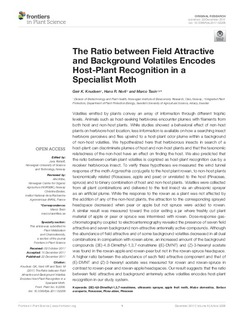| dc.contributor.author | Knudsen, Geir | |
| dc.contributor.author | Norli, Hans | |
| dc.contributor.author | Tasin, Marco | |
| dc.date.accessioned | 2018-06-26T17:02:39Z | |
| dc.date.available | 2018-06-26T17:02:39Z | |
| dc.date.created | 2018-01-09T13:50:03Z | |
| dc.date.issued | 2017-12-22 | |
| dc.identifier.citation | Frontiers in Plant Science. 2017, 8 . | nb_NO |
| dc.identifier.issn | 1664-462X | |
| dc.identifier.uri | http://hdl.handle.net/11250/2503082 | |
| dc.description.abstract | Volatiles emitted by plants convey an array of information through different trophic levels. Animals such as host-seeking herbivores encounter plumes with filaments from both host and non-host plants. While studies showed a behavioral effect of non-host plants on herbivore host location, less information is available on how a searching insect herbivore perceives and flies upwind to a host-plant odor plume within a background of non-host volatiles. We hypothesized here that herbivorous insects in search of a host-plant can discriminate plumes of host and non-host plants and that the taxonomic relatedness of the non-host have an effect on finding the host. We also predicted that the ratio between certain plant volatiles is cognized as host-plant recognition cue by a receiver herbivorous insect. To verify these hypotheses we measured the wind tunnel response of the moth Argyresthia conjugella to the host plant rowan, to non-host plants taxonomically related (Rosaceae, apple and pear) or unrelated to the host (Pinaceae, spruce) and to binary combination of host and non-host plants. Volatiles were collected from all plant combinations and delivered to the test insect via an ultrasonic sprayer as an artificial plume. While the response to the rowan as a plant was not affected by the addition of any of the non-host plants, the attraction to the corresponding sprayed headspace decreased when pear or apple but not spruce were added to rowan. A similar result was measured toward the odor exiting a jar where freshly cut plant material of apple or pear or spruce was intermixed with rowan. Dose-response gas-chromatography coupled to electroantennography revealed the presence of seven field attractive and seven background non-attractive antennally active compounds. Although the abundance of field attractive and of some background volatiles decreased in all dual combinations in comparison with rowan alone, an increased amount of the background compounds (3E)-4,8-Dimethyl-1,3,7-nonatriene ((E)-DMNT) and (Z)-3-hexenyl acetate was found in the rowan-apple and rowan-pear but not in the rowan-spruce headspace. A higher ratio between the abundance of each field attractive component and that of (E)-DMNT and (Z)-3-hexenyl acetate was measured for rowan and rowan-spruce in contrast to rowan-pear and rowan-apple headspaces. Our result suggests that the ratio between field attractive and background antennaly active volatiles encodes host-plant recognition in our study system. | nb_NO |
| dc.description.abstract | The Ratio between Field Attractive and Background Volatiles Encodes Host-Plant Recognition in a Specialist Moth | nb_NO |
| dc.language.iso | eng | nb_NO |
| dc.publisher | Frontiers Media S.A | nb_NO |
| dc.rights | Navngivelse 4.0 Internasjonal | * |
| dc.rights.uri | http://creativecommons.org/licenses/by/4.0/deed.no | * |
| dc.subject | (3E)-4,8-Dimethyl-1,3,7-nonatriene | nb_NO |
| dc.subject | ultrasonic sprayer | nb_NO |
| dc.subject | apple fruit moth | nb_NO |
| dc.subject | Malus domestica | nb_NO |
| dc.subject | Sorbus aucuparia | nb_NO |
| dc.subject | Rosaceae | nb_NO |
| dc.subject | Picea abies | nb_NO |
| dc.subject | Pinaceae | nb_NO |
| dc.title | The Ratio between Field Attractive and Background Volatiles Encodes Host-Plant Recognition in a Specialist Moth | nb_NO |
| dc.type | Journal article | nb_NO |
| dc.type | Peer reviewed | nb_NO |
| dc.description.version | publishedVersion | nb_NO |
| dc.rights.holder | Copyright © 2017 Knudsen, Norli and Tasin | nb_NO |
| dc.source.pagenumber | 11 | nb_NO |
| dc.source.volume | 8 | nb_NO |
| dc.source.journal | Frontiers in Plant Science | nb_NO |
| dc.identifier.doi | 10.3389/fpls.2017.02206 | |
| dc.identifier.cristin | 1538848 | |
| cristin.ispublished | true | |
| cristin.fulltext | original | |
| cristin.qualitycode | 1 | |

